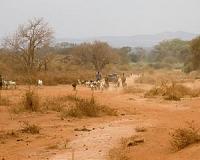 |
Washington (AFP) March 31, 2011 Toughened by a punishing annual migration in western Canada, a special breed of sockeye salmon has proved better able to survive environmental change than other members of the species, a study said Thursday. The Fraser River in British Columbia has more than 100 distinct populations of sockeye salmon, many of them so fine-tuned to their environment that even slight changes in water temperature, river flow or elevation change could spell disaster. "As climate change alters the conditions of the Fraser River watershed, our concern is that some populations may not be able to adapt to these changes quickly enough to survive," said Erika Eliason, the study's lead author. But the Chilko salmon, named after a region of the river where they spawn, are proving more resilient than others, and Eliason and her colleagues at University of British Columbia believe it could be due to their harsher migration conditions. "I like to call the Chilko population of sockeye 'Superfish,'" said Eliason, who explained they are conditioned by a migratory route that is extraordinarily difficult. Eliason and colleagues studied eight sockeye populations for the study, which was published in the journal Science. "This is the first large study examining how different populations of fish of the same species adapt to different environmental conditions during their annual migration," she said. Scientists say the Fraser River, which runs some 2,000 kilometers (1,240 miles), has already warmed by almost two degrees Celsius since the 1950s, with the last 20 years among the warmest on record. Millions of sockeye migrate up the Fraser to spawn each year, but the species has been in decline since the 1990s. There have been mass mortalities during migrations, when between 40 and 95 percent of some populations have died, according to UBC. The sockeye populations follow exact migration routes that vary by distance, elevation, temperature and current strength. Some have it easy, but not the Chilko. The Chilko must swim more than 650 kilometers (400 miles) upstream, gain a kilometer (0.6 miles) in elevation, and pass through an area known as Hell's Gate, where the river shoots through a passage just 35 meters (115 feet) wide. They do all this at the height of summer in a heroic effort to reach a glacial lake, where they spawn. To assess the salmon's abilities to cope with changing environmental conditions, the UBC team had fish from the eight population groups swim through a large tube designed to simulate Fraser river currents and water temperatures. The scientists measured the heart rates and metabolism of the adult salmon as they did so. They found that when water temperatures rose above an optimal level, the salmon's ability swim declined, probably as a result of a weakening of their cardiovascular systems. But they also observed that the Chilko sockeye seemed physiologically less sensitive to the difference in temperature and other environmental change. The most sensitive was the Weaver sockeye. Eliason said the Chilko were able to "swim at higher and a broader range of temperatures" compared to other sockeye in the river. "We believe it has to do with how they've adapted to cope with their difficult migration."
Share This Article With Planet Earth
Related Links Farming Today - Suppliers and Technology
 Calculating Livestock Numbers By Weather And Climate
Calculating Livestock Numbers By Weather And ClimateWashington DC (SPX) Apr 01, 2011 Ranchers in the central Great Plains may be using some of their winter downtime in the future to rehearse the upcoming production season, all from the warmth of their homes, according to U.S. Department of Agriculture (USDA) soil scientists. The ranchers would use the GPFARM (Great Plains Framework for Agricultural Resource Management)-Range computer model to see which cattle or sheep stoc ... read more |
|
| The content herein, unless otherwise known to be public domain, are Copyright 1995-2010 - SpaceDaily. AFP and UPI Wire Stories are copyright Agence France-Presse and United Press International. ESA Portal Reports are copyright European Space Agency. All NASA sourced material is public domain. Additional copyrights may apply in whole or part to other bona fide parties. Advertising does not imply endorsement,agreement or approval of any opinions, statements or information provided by SpaceDaily on any Web page published or hosted by SpaceDaily. Privacy Statement |